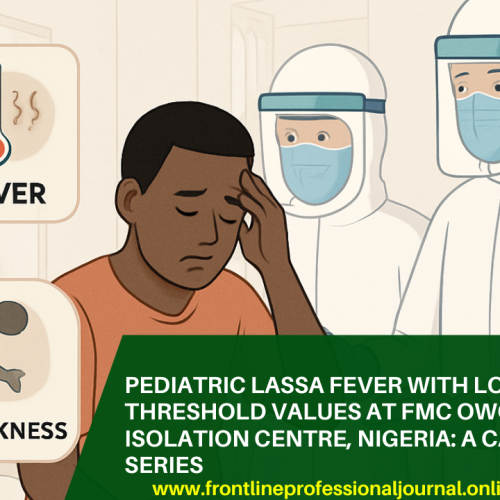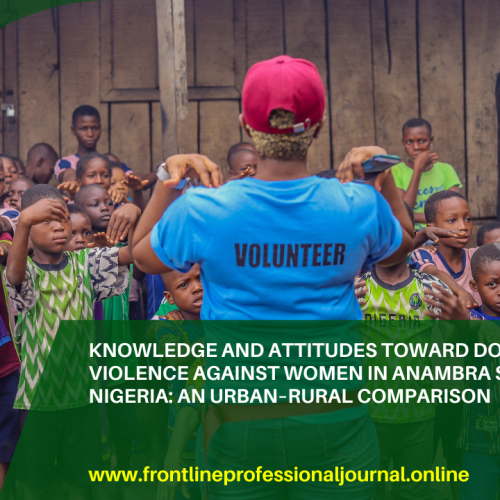Irene Uju Okeke, Debra Ukamaka Okeh, Perpetua Onyinye Nnemelu, Uzoma Chidi Okereke, Martins Nwabueze Okolie, Chidozie Reginald Aniemena
Citation: Okeke I U, Okeh D U, Nnemelu P O, Okereke U C, Okolie M N, Aniemena C R (2025)
Willingness to pay for school feeding among caregivers of school children in urban-rural
community of southeast Nigeria. Frontline Professionals Journal, 2(1), 13 – 33
ABSTRACT
Background: School feeding programs have been implemented in Nigeria to improve education outcomes and reduce hunger among school children. However, sustaining these programs remains a challenge. In Southeast Nigeria, urban-rural disparities in socioeconomic status, food security, and access to education exist, affecting caregivers’ ability and willingness to pay for school feeding programs. Understanding the willingness to pay among caregivers in this region is crucial for designing sustainable school feeding programs. School feeding programme is a targeted social safety nets that provides both educational and health benefits to the most vulnerable children, thereby increasing enrolment rates, reducing absenteeism, and improving food security at the household level. It enhances the diet and increases the energy and kilocalories available to a child. It targets micronutrient deficiencies, which are widespread among school-age children in developing countries and which increase susceptibility to infection, leading to absenteeism and impairing learning capacity and cognition. Willingness to pay for school feeding is a potentiator to reversing the negative consequences of increasing susceptibility to infection, absenteeism, impaired learning and malnutrition
Methodology: This study was a comparative, cross-sectional descriptive study carried out in the selected communities in Enugu State, South East Nigeria., involving households four (two urban and two rural) communities. The sample size was 422 where participant were selected using multistage sampling technique The questionnaire was adapted from National Health Demographic Health Survey, pre-tested semi-structured interviewer administered in English language. Data were collated, assembled and analysed using International Business Machine (IBM), Statistical Package for Social Science (SPSS) version 23. Descriptive statistics as percentages and frequency were presented in tables. The mean and standard deviation of parameters in each community were obtained and statistical tests of association between the dependent and independent variables were also carried out and the level of statistical significance was set at P ≤ 0.05. The research protocol was reviewed and approval for the project was sought from the Ethics Review Committee of Nnamdi Azikiwe University Teaching Hospital. Consents were gotten from traditional rulers/village heads before the commencement of the study. All subjects had the right to withdraw from the study anytime they wish without explanation. Confidentiality was maintained throughout the study.
Results: Most of the respondents were female 262 (62.4%) and 158 (37.6%) were males with majority of the respondents having formal education 401 (95.48%) and 194 (46.19%) completed tertiary education. Majority of the respondents were household representatives 254 (60.5%). On Marital status of respondents 371 (88.3) were married, followed by 34(8.1%) respondents that were single parents. 159 of the 420 (37.9%) respondents were government employee, 113 (37%) respondents were self-employed and 70 (16.7%) of the respondents were unemployed. 136 (65.07%) respondents in urban areas werE willing to pay for the school feeding program. 15 (7.17%) respondents in urban areas were willing to pay N9, 000 while in the rural were 1 (0.47%) respondent. For N6,000 were 17 (8.13%) respondents in urban and 2 (0.94%) in rural. The association between position in household and WTP was not statistically significant in the urban area X2 = 2.54, p = 0.07 while it was statistically significant in the rural area X2 = 26.26, p = 0.00. The association between gender and WTP was statistically significant in the rural area with
majority as females. Also in rural areas the association between Age and WTP and Level of Education and WTP were all statistically significant. The association between marital status and WTP was statistically significant in the urban area X2 =6.35, p=0.01. The association between WTP N9, 000 was statistically significant with level of education in the urban areas X2 = 26.0, p = 0.00 and major source of income X2 = 8.79, p = 0.00 while in the rural areas WTP N9,000 was statistically significant with marital status. The association between WTP N6,000 was statistically significant with major source of income and Marital status in urban areas. The association between WTP N3,000 was statistically significant with level of education, major source of income and marital status in the urban areas The relationship between willingness to pay for school feeding and socioeconomic status was statistically significant across all the socioeconomic groups with X2 = 16.93, p=0.00. The mean amount the respondents were willing to pay yearly for school feeding were N2, 053:35 in urban areas and N671:33 in rural areas. There is a positive correlation between willingness to pay for school feeding and household heads, gender, age and major source of income while there is negative correlation with number of children in primary school, had formal education and highest level of education. The association between willingness to pay and gender was statistically significant at 0.046, with age at 0.027 and with highest level of education at 0.000..
Conclusion: The willingness to pay for school feeding among caregivers of school children in urban-rural communities in Southeast Nigeria is a critical aspect of ensuring the sustainability of school feeding programs. The study’s findings suggest that caregivers in these communities place a high value on education and recognize the importance of nutrition in supporting their children’s learning outcomes. While there are variations in willingness to pay between urban and rural areas, the overall sentiment indicates that caregivers are willing to contribute financially to school feeding programs. This willingness is likely driven by the perceived benefits of improved nutrition and education outcomes. However, the study also highlights the need for policymakers and program implementers to consider the socioeconomic dynamics of urban-rural communities in Southeast Nigeria. Strategies to increase willingness to pay, such as flexible payment plans and community engagement, may be necessary to ensure the long-term sustainability of school feeding programs. Ultimately, understanding the willingness to pay for school feeding among caregivers can inform the design of effective and sustainable school feeding programs that support the education and nutrition needs of school children in the region.
Keywords: Willingness to pay, school feeding, school-age children, Caregivers.







